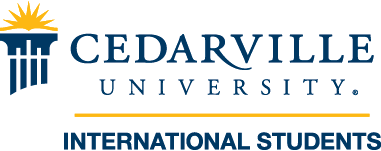We are so excited to welcome you to campus! Before you arrive, make sure you complete these steps to ensure a smooth transition to your studies in the United States.
First Steps
Make sure you've followed the application process into Cedarville for international students, including these next steps. Once you've received your I-20 by email, you're ready to move on in the process!
Applying for an F-1 Visa
1. Pay Your SEVIS Fee
You'll need to pay your I-901 SEVIS fee to the U.S. Department of Homeland Security before you can continue applying for a visa.
Choose one of these two methods to pay your fee:
- Complete Form I-901 electronically using a credit card. Make sure you complete this at least three business days before the scheduled visa interview. This will allow time for the fee payment to be confirmed in SEVIS (Student and Exchange Visitor Information System).
- Use Western Union Quick Pay where available and in those countries from which credit card payments aren't accepted by USCIS.
Make sure to print a receipt of the SEVIS fee payment, as you'll need this to receive your visa.
2. Complete Your Application for a Nonimmigrant Visa
Complete the DS-160 form, used by the U.S. Department of State along with your interview to help determine your eligibility for a nonimmigrant visa. When you're done, be sure to print or save the confirmation page, as you'll need this during your interview at the embassy or consulate.
3. Schedule Your Interview
Find the U.S. embassy or consulate closest to you to schedule your visa interview. Review all information on the embassy or consulate's website about the local process for scheduling an interview. Often, this scheduling is handled by a call center. Be sure to also check the wait times for securing an interview appointment at your local embassy or consulate.
You'll also need to pay your $185 visa application fee at this point in the process. See your local embassy or consulate website for specific instructions, and make sure to keep your payment receipt.
4. Prepare Your Interview Documents
You'll need to bring the following documents with you to your interview:
- Your I-20
- SEVIS fee payment receipt
- DS-160 completion confirmation
- Application fee payment receipt
- Letter of admission to Cedarville
- A valid passport (which must be valid for at least six months beyond your period of stay in the U.S.)
- Proof of financial support (which should match the funding information you submitted when you applied to Cedarville)
- Proof of academic preparation (high school transcripts, test scores, etc.) and of your intent to depart from the U.S. after program completion may also be requested by the officer conducting your interview.
Learn more about preparing for your visa interview.
5. Complete Your Interview
Be prepared to answer a few questions about why you chose Cedarville University (mention unique interests) and what you plan to do after completing your degree. Your visa is likely to be rejected if the consular official believes you wish to stay in the U.S. permanently after graduating. You should be able to explain how your education will help you when you return to your home country.
View a helpful list of things to remember when interviewing for a student visa.
Entering the United States
You'll be permitted to enter the Unites States within 30 days of the start date of your program, but no earlier.
At the port of entry, the immigration official will request your passport (with your visa stamped in it) and your I-20. The official will create an I-94, which is an electronic record of your arrival to the U.S. You'll be able to access your I-94 on the U.S. Customs and Border Protection website and print it for your records.
Maintaining Your Visa Status
There are some basic requirements for maintaining your F-1 visa status while studying in the U.S. Familiarize yourself with these requirements:
- Follow the guidelines for duration of status
- Follow student employment regulations
- Keep documents and records up to date
- Follow the guidelines for traveling outside the U.S.
- Follow the guidelines for transfer students
- Register for full-time studies each semester by enrolling in at least 12 credit hours.
- Inform the Registrar or International Student Services of any changes to your address within 10 days of an address change.
Government Resources
I-901 SEVIS Fee Frequently Asked Questions
Student Visa Guide (U.S. Department of State)
Study in the States Guide (U.S. Department of Homeland Security)
U.S. Citizenship and Immigration Services
U.S. Embassy and Consulate List



















